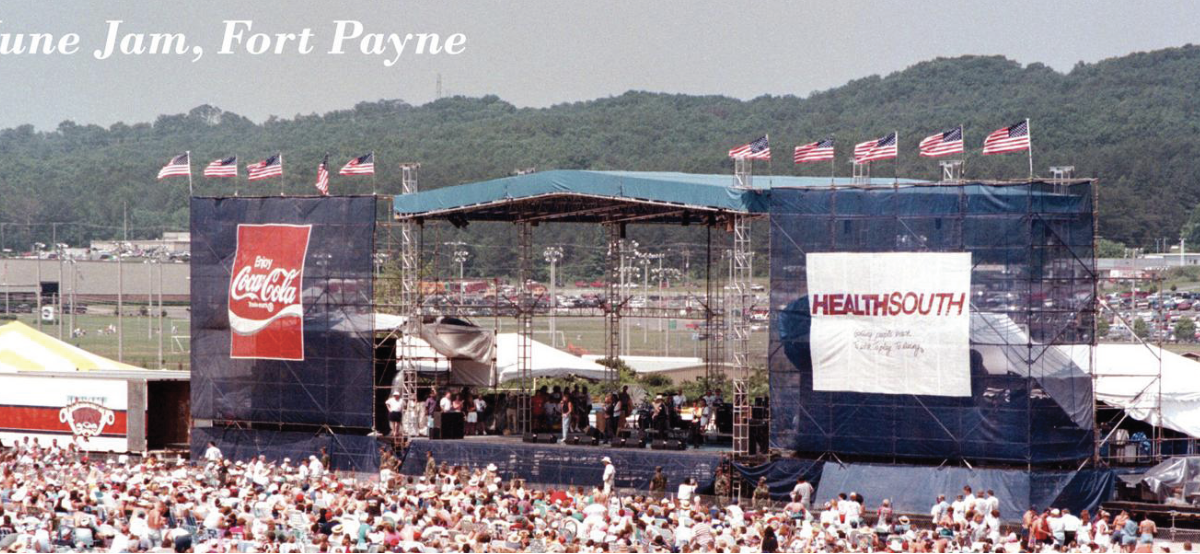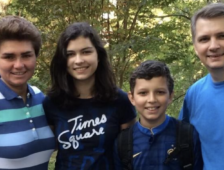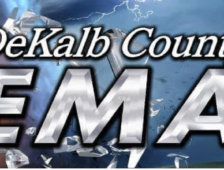By Marla Ballard
Reporter
June Jam ran from 1982 to 1997, the event has never been just a musical performance. The occasion is about bringing people together, supporting those in need, and giving a small town an opportunity to show its big heart by volunteering.
Civic clubs and other organizations volunteer to provide parking services, sell tickets, operate the lost and found, and secure various areas of the venue. The June Jam is supported by law enforcement, medical personnel, city officials and city employees.
The Lead Singer of ALABAMA, Randy Owen, was quoted in an 1984 edition of the Times-Journal, “I want to say a special thanks to all the local people in DeKalb County, Fort Payne, Alabama, the state of Alabama, and everybody for all the volunteer work that they’ve done. There’s no way that we could entertain you without the volunteers that help for no money whatsoever.”
When the music festival ends more than memories live on, the group effort benefits multiple organizations, causes, charities, public safety departments, medical facilities, learning institutions, and community centers.The first year of the Jam mostly youth-oriented agencies received June Jam money. Of the $219,000 distributed in the fall of 1982, each of the nine high schools received $2,000, $2,000 scholarships were set up at each school. Forest Ave. School received $10,000, Camp Comer for Boy Scouts $10,000, and each of the 10 troops in the county received $1,000.
Bass guitarist Teddy Gentry and Owen attended Adamsburg School when it had no gymnasium. That school received $40,000 to help complete the gym. Other contributions included: The Adult Activity Training Center, the mental health association, rescue squads, the opera house, the aging, the Fraternal Order of Police, the hospital, and the city recreation department.
In 1981 a one-time homecoming concert was held at the Fort Payne High School stadium, but this event was not labeled as a June Jam. This concert was held on a Friday and the decision was made the following year to move the concert to a Saturday so more people could attend.
On June 4, 1982 the first official June Jam took place on an open field near the high school. The first year the expenses were enormous and measures were put into place to reduce expenditures so more money could go directly to needy agencies. Since ALABAMA already had a paid staff of stage, sound, and lighting specialists, it was decided that they would perform these same services at the second June Jam.
Local people were asked to provide catering, security, and other necessary services that were so expensive the first time, when professionals were hired to perform these duties. As a result of all the community effort and the volunteering expenses were cut in half and the agencies benefitting from the Jam received more funding.
The first June Jam was reported to have 22,000, the official count for June Jam 2 in 1983 was 37,684, with fans reportedly coming from 30 states and as far away as Italy.
Gaynelle Pitts, who helped coordinate the Jam was quoted in the Times Journal as saying, “ June Jam 3 was better than June Jam 2, and not as good as June Jam 4.” She was right, the number of those attending in the following years kept growing. The population of Fort Payne would, at times, quadruple in one day. It was predicted that June Jam 3 would draw a crowd of 40,000, it drew over 41,000.
By June Jam 3 nationwide television programs “Entertainment Tonight,” “Good Morning America,” and “20/20,” were promoting the concert. Greg Fowler, head of promotions, said in 1984, “We have tremendous support from the media. We would have to spend as much as $300,000 (more than the first June Jam raised for charity) if we had to pay for these promotions. The June Jam does what it sets out to do, it’s not just another concert.”
June Jam V saw crowds of nearly 60,000. This was the same year the parade, street dance, and team competition night were added to the festivities. Team Competition Night featured timed field events – such as a three-legged race and wheelbarrow race.
The Miss June Jam Week Beauty Pageant was organized for June Jam VI in 1987 and the winner presided over the week of events. The same year the arts and crafts fair and the gospel jamboree joined in.
The Randy Owen Celebrity Golf Classic has raised hundreds of thousands of dollars for the Alabama Sheriff’s Ranches. The Celebrity Golf Classic was first organized by Paul Crow in 1975 at the Terrapin Hills Golf Club. Owen came on board in 1985 and joined efforts with Crow in raising money for the sheriff’s ranches. In 1987 the annual golf benefit was titled The Randy Owen Celebrity Classic Golf Tournament.
June Jam VII in 1988 boosted the number of acts to 20. Ticket prices were raised for the first time to $25 and $300,000 was raised for charity.
The “Roll On” Custom Motorcycle and Classic Car Show and Arts and Craft Show at the VFW Fairgrounds were both added in 1989. In 1989, Stanley Byrd, co-coordinator of the car show, said he was pleased with the results. “We had sixty-two cars and we would have had one hundred if the sun had been shining at eight o’clock.” More than $600 in cash, trophies, and door prizes were presented to the participants. The same year saw the beginning of the June Jam Soccer Classic, featuring more than 50 teams from around the south.
June Jammer, Rhonda McKinney of Virginia Beach, Va. was quoted while attending the 1989 Jam as saying, “This is our fifth June Jam. We came once to see what the jam was all about and we had so much fun we just kept coming back. Most people think we are crazy for camping out. They think we camp out to get a good seat, but we camp out because it is fun and we meet a lot of nice people. The whole week is complete entertainment.”
In 1990 environmental concerns began to take center stage with ALABAMA and recycling containers were placed throughout the Jam site. In conjunction with this act a balloon display on the hill behind the site spelled out the words, Pass It On Down, which seemed to take top billing over the “Comin’ Home to Jam” billing originally used to advertise the festival.
The June Jam evolved over the years from a single concert into an 11-day festival. The idea for additional events for Jam fans began in 1985. “We need to give the fans something to do aside from the Jam,” said Coordinator of Events, Brant Craig, in 1991.
The first June Jam Week activity was a softball game between a team associated with the group ALABAMA and a team of local civic leaders, businessmen and public figures. By 1991 fans were able to see nationally known entertainers up close as they participated in the event. It was not uncommon for well-known sports figures – coaches and players – to show up for the game.
The June Jam has raised millions for charities and the revival this year will mark 26 years since it was last held. June Jam may have put Fort Payne on the map, but it also put good memories in the hearts of all involved.





